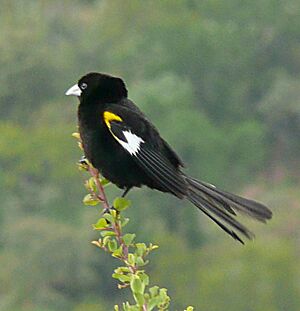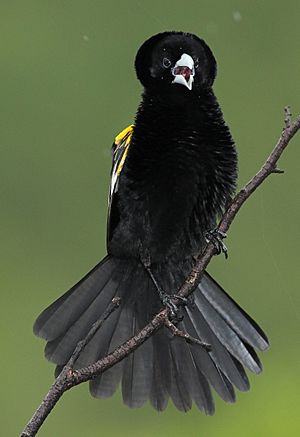White-winged widowbird facts for kids
Quick facts for kids White-winged widowbird |
|
|---|---|
 |
|
| Breeding plumage male in Pilanesberg Game Reserve, South Africa | |
| Conservation status | |
| Scientific classification | |
| Genus: |
Euplectes
|
| Species: |
albonotatus
|
The white-winged widowbird (Euplectes albonotatus) is a type of passerine bird that lives in Africa, south of the Sahara desert. It belongs to the Ploceidae family, which includes many kinds of weaver birds.
These birds look very different depending on the season. During breeding season, the male's yellow feathers turn dark, and he gets more white feathers. This makes him stand out from the female, who usually has lighter colors. There are three main types, or subspecies, of this bird.
Contents
About the White-winged Widowbird
The white-winged widowbird was first described by an American bird expert named John Cassin in 1848. Sometimes, these birds are also called the white-fronted widowbird or the white-shouldered whydah.
Different Types of White-winged Widowbirds
There are three recognized subspecies of the white-winged widowbird. Each lives in slightly different parts of Africa.
- E. a. albonotatus (Cassin, 1848): This type lives in countries like Tanzania, Zambia, Malawi, Botswana, Zimbabwe, Mozambique, Eswatini, and South Africa. It also lives in parts of the Democratic Republic of the Congo and Namibia.
- E. a. eques (Hartlaub, 1863): This type is also known as the cinnamon-shouldered widowbird. You can find it in the Central African Republic, Sudan, Ethiopia, Rwanda, Burundi, Uganda, Kenya, and Tanzania.
- E. a. asymmetrurus (Reichenow, 1892): This type lives in São Tomé, Gabon, the Republic of the Congo, the Democratic Republic of the Congo, and Angola.
What They Look Like
The white-winged widowbird is about 15 to 19 centimeters (6 to 7.5 inches) long. It weighs around 23 grams (0.8 ounces), which is about the same as a few quarters.
The male bird is special because it's the only short-tailed widowbird in its area with white feathers on its wings. During breeding season, the male looks different from the yellow-mantled widowbird because it has a shorter tail and different wing colors. It also doesn't have yellow on its back, and its beak is lighter. Female white-winged widowbirds are usually pale on their undersides.
Where They Live and What They Like
You can find the white-winged widowbird in many African countries. These include Angola, Botswana, Burundi, Central African Republic, the Republic of the Congo, the Democratic Republic of the Congo, Ethiopia, Eswatini, Gabon, Kenya, Malawi, Mozambique, Namibia, Rwanda, São Tomé, South Africa, Sudan, Tanzania, Uganda, Zambia, and Zimbabwe.
They prefer to live in savannas, grasslands, and wet areas. They also like cultivated land, which is land used for farming. Their call sounds like "zeh-zeh-zeh" and "witz-witz-witz."
Life Cycle and Behavior
White-winged widowbirds live in groups. One male bird will mate with about 3 to 4 females. This is called being polygynous.
The male bird is the one who builds the nests. These nests are oval-shaped and are usually found in the branches of trees or bushes. Nesting season runs from November to May, with the busiest time being from December to March.
The female bird will lay a clutch of two to four white eggs. She sits on the eggs to keep them warm, which is called incubating, for about 12 to 14 days. Once the chicks hatch, the female feeds them in the nest for 11 to 14 days. The young birds become independent about 22 to 25 days after hatching.
These birds mostly eat grass seeds, sweet nectar from flowers, and insects.



